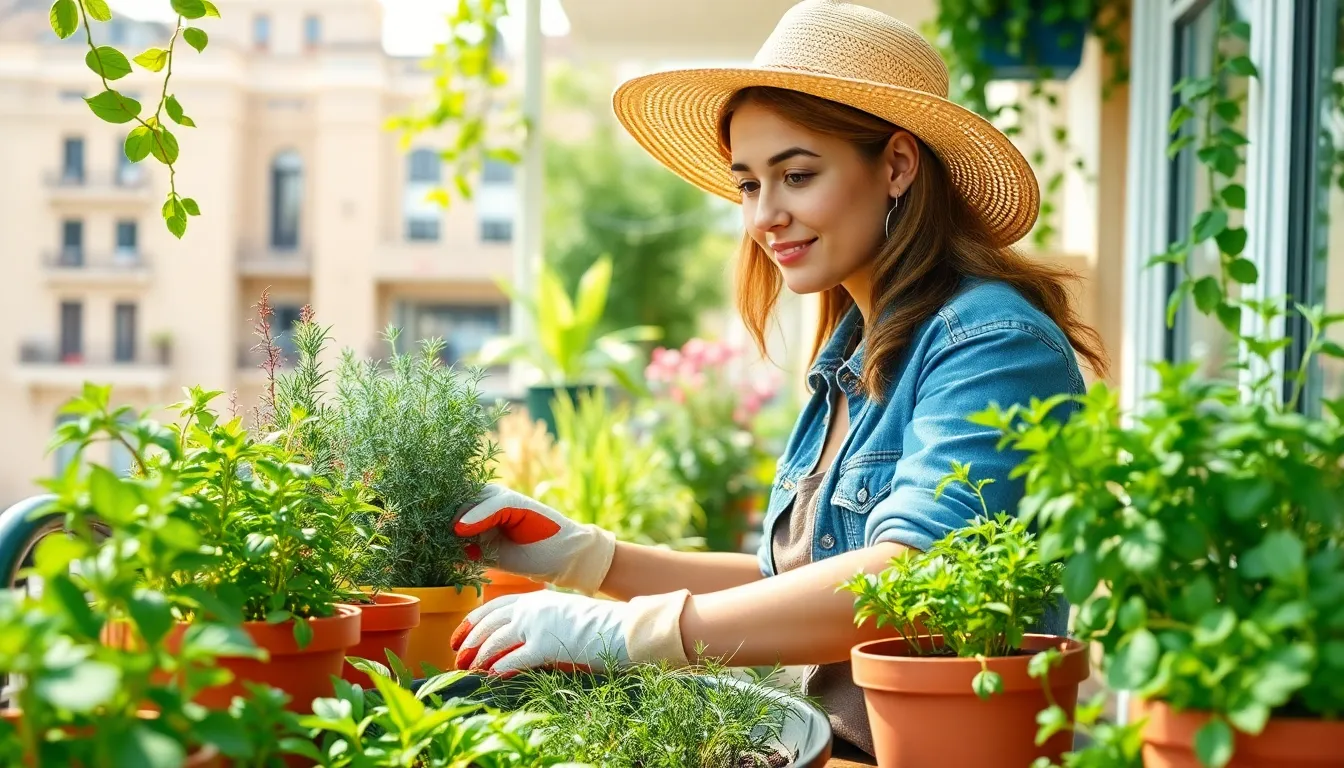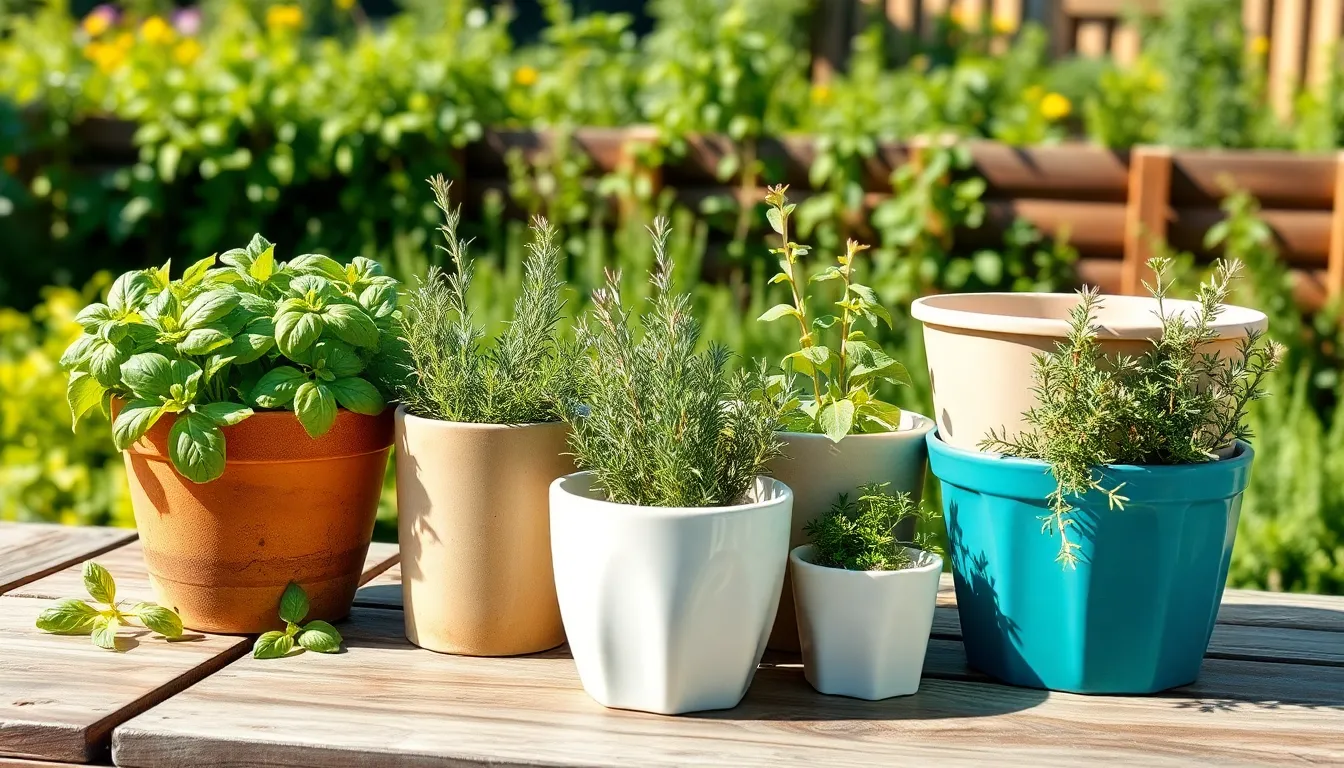Phone:
(701)814-6992
Physical address:
6296 Donnelly Plaza
Ratkeville, Bahamas.

Imagine stepping out onto your balcony or patio and being greeted by a fragrant oasis of fresh herbs. Herb container gardening isn’t just a trend; it’s a lifestyle choice that transforms ordinary spaces into culinary havens. Whether you’re a seasoned chef or someone who occasionally burns toast, growing herbs in containers can elevate your cooking game and impress your dinner guests—who’ll never know how easy it was!
Herb container gardening offers a flexible way to grow fresh herbs, making it suitable for various living spaces, including balconies and small patios. It enhances any outdoor or indoor environment while providing convenient access to fresh ingredients. Container gardening requires minimal space, so even those with limited yards can cultivate their favorite herbs.
Easy care defines herb containers, necessitating less effort than traditional gardening. Simple maintenance practices like regular watering and periodic pruning are often all that’s needed to thrive. Utilizing various pot sizes, gardeners can create arrangements that reflect personal style and maximize the use of sunlight.
Choosing the right herbs is essential for successful container gardening. Popular options include basil, rosemary, parsley, and mint, as these herbs adapt well to container life. Varieties can offer different flavors, so mixing and matching adds both aesthetic and culinary diversity.
Placement plays a critical role in the health of container herbs. Containers should receive at least six hours of sunlight daily for optimal growth. Selecting a location that protects herbs from harsh winds enhances their resilience and boosts productivity.
Finally, understanding the importance of soil can elevate herb container gardening. A well-draining potting mix facilitates healthy root growth and minimizes the risk of overwatering. Using organic fertilizers can provide essential nutrients while promoting sustainability in gardening practices.

Selecting suitable containers plays a significant role in successful herb container gardening. Various factors influence the choice, including material, size, and drainage.
Containers come in different materials like plastic, clay, ceramic, and metal. Plastic is lightweight, affordable, and retains moisture effectively. Clay provides excellent breathability but dries out faster. Ceramic offers aesthetic appeal and insulation but can be heavy. Metal containers may heat up quickly, affecting root temperature, which can stress delicate herbs. Each material impacts moisture retention and overall growth conditions.
Choosing the right size ensures herbs have sufficient room to thrive. Containers need to be at least 6 to 12 inches deep for proper root development. Opt for larger containers when growing multiple herbs. Adequate drainage holes are essential, as they prevent root rot and promote healthy growth. Always prioritize pots with drainage features to facilitate water flow, which is crucial for herb survival. Keeping size and drainage in mind supports vibrant herb growth and a more successful gardening experience.
Selecting the right herbs for container gardening plays a crucial role in gardening success. Choosing popular varieties ensures a bountiful harvest.
Basil thrives in containers, making it a favorite among chefs. It adds flavor to pasta and salads. Rosemary, with its aromatic leaves, enhances dishes like roasted meats. Oregano’s robust flavor enhances sauces and pizzas. Parsley works well as a garnish and ingredient in various cuisines. Chives bring a mild onion flavor, complementing soups and salads. Cilantro’s versatility makes it perfect for salsa and other dishes. Each of these herbs can flourish in containers, providing fresh ingredients for any home cook.
Peppermint serves well for its soothing properties, aiding digestion. Lavender, known for its calming scent, promotes relaxation. Chamomile’s flowers provide herbal tea with sleep benefits. Echinacea strengthens the immune system, popular during cold seasons. Lemon balm aids stress relief and enhances teas. Each of these medicinal herbs has specific uses, making them ideal for both health benefits and container gardening. Consider planting these varieties to enjoy their therapeutic properties alongside culinary uses.
Herb container gardening allows for innovative design and functionality. Gardeners can explore various creative solutions to maximize space and aesthetics while cultivating flavorsome herbs.
Vertical gardening solutions make superior use of limited space. Multi-tiered plant stands and wall-mounted planters can support multiple herb varieties in a compact area. Utilizing vertical spaces also enhances airflow and sunlight exposure. Consider installing lattice panels or trellises as a support mechanism for climbing herbs. Herbs like thyme and climbing peas thrive in these setups, adding dimension to outdoor or indoor environments.
Hanging herb gardens introduce a unique element to spaces. They can be designed using macramé hangers or ceiling-mounted brackets, ideal for small patios or kitchens. This method allows herbs to cascade down beautifully, creating an eye-catching display. Herbs like strawberry mint and trailing rosemary flourish in these arrangements. Position these hanging gardens near windows for optimal sunlight while keeping them accessible for harvesting.
Use of repurposed materials offers an eco-friendly approach to herb container gardening. Gardeners can transform old crates, tin cans, or wooden pallets into functional containers. These materials not only provide creative visuals but also encourage sustainable gardening practices. Drainage holes can be easily added to most repurposed items, ensuring healthy herb growth. Each unique piece reflects personal style while contributing to a thriving container garden.
Regular maintenance ensures vibrant herb growth in containers. Attention to watering and fertilization routines significantly affects plant health.
Watering frequency relies on climate and pot size. Containers dry out faster than garden beds, requiring more frequent checks. Aim to keep the soil consistently moist but not waterlogged. Use a high-quality liquid fertilizer every four to six weeks for optimal growth and nutrient supply. Organic options, such as fish emulsion or compost tea, enhance soil quality and support sustainability.
Pest control for herb containers involves monitoring and preventive measures. Frequent inspections help identify issues early. Introduce beneficial insects like ladybugs or aphid parasites to manage pests naturally. Use insecticidal soap or neem oil for more significant infestations, applying them in the early morning or late evening. Companion planting, which includes placing marigolds or basil near herbs, can deter pests and promote a healthier environment.
Herb container gardening offers a delightful way to bring fresh flavors and greenery into any space. Whether it’s a small balcony or a spacious patio these ideas make it easy to cultivate herbs that enhance culinary experiences. By choosing the right herbs and containers while ensuring proper sunlight and drainage anyone can enjoy the benefits of homegrown ingredients.
Incorporating creative solutions like vertical gardens or repurposed materials adds a unique touch to the gardening experience. With a little care and attention to maintenance herb containers can thrive and provide a continuous supply of fresh herbs. This approach not only enriches meals but also fosters a deeper connection to nature and sustainable living.